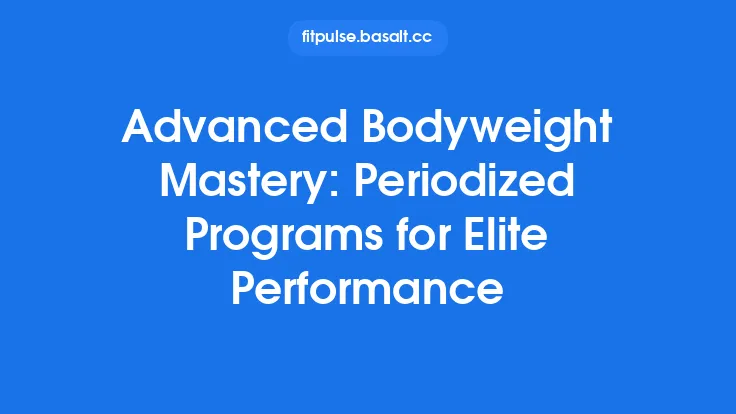Bodyweight training thrives on the principle of progressive overload, yet the way overload is applied can differ dramatically from traditional weight‑lifting paradigms. Because the stimulus comes from manipulating body position, leverage, tempo, and volume rather than adding external plates, a well‑structured periodization model becomes essential for continued adaptation. By cycling deliberately through beginner, intermediate, and advanced phases, athletes can align skill acquisition, strength development, and metabolic conditioning in a way that respects the unique demands of calisthenics.
Understanding Periodization in the Context of Bodyweight Training
Periodization is the systematic planning of training variables—volume, intensity, frequency, and exercise selection—over defined time blocks. In bodyweight disciplines, “intensity” often translates to the difficulty of the movement (e.g., progressing from a standard push‑up to an archer push‑up) while “volume” is expressed in sets, reps, and total time under tension. A periodized approach prevents plateaus, reduces injury risk, and ensures that technical proficiency evolves alongside strength.
Key concepts that differ from barbell‑centric periodization include:
- Leverage Manipulation – Changing the center of gravity (e.g., elevating feet, using rings) alters the mechanical load without adding weight.
- Skill‑Intensity Coupling – Complex skills (handstand, muscle‑up) inherently raise intensity because they demand neuromuscular coordination, not just muscular force.
- Time‑Under‑Tension (TUT) as a Primary Load Metric – Slower tempos or paused repetitions increase metabolic stress and can serve as a progressive overload tool.
Why Cycle Between Beginner, Intermediate, and Advanced Phases?
A level‑based cycle respects the natural learning curve of bodyweight athletes:
- Foundational Motor Patterns – Beginners need to cement basic joint stability, scapular control, and core bracing.
- Strength‑Skill Integration – Intermediates can handle higher loads but still require focused practice on movement quality.
- Specialization & Maximal Load – Advanced athletes can tolerate high‑intensity variations and large training volumes, allowing for fine‑tuning of elite skills.
Cycling through these phases prevents the “one‑size‑fits‑all” trap where an athlete remains stuck at a sub‑optimal difficulty level, leading to stagnation or overuse injuries.
Macrocycle Design: Mapping the Three Levels
A macrocycle typically spans 12–24 weeks, though the exact length can be adjusted based on competition schedules, personal goals, or life constraints. A common structure is:
| Phase | Duration | Primary Focus | Representative Movements |
|---|---|---|---|
| Beginner | 4–8 weeks | Motor control, basic strength, joint mobility | Standard push‑up, bodyweight squat, Australian pull‑up, hollow hold |
| Intermediate | 6–10 weeks | Load progression, skill refinement, hypertrophy | Decline push‑up, pistol squat progression, ring rows, L‑sit |
| Advanced | 8–12 weeks | Maximal difficulty, complex skill work, power | Planche lean, front lever raises, one‑arm push‑up, weighted dips |
Each phase is a mesocycle within the macrocycle. The transition between phases is not abrupt; a transition week (often a deload or active recovery week) eases the shift in intensity and volume.
Microcycle Structure Within Each Level
A typical microcycle (one week) can be organized around the classic push‑pull‑legs split, a full‑body approach, or a skill‑focused schedule. The choice depends on the athlete’s training frequency (3–6 sessions per week) and the specific skill set being targeted.
Example of a 4‑day microcycle for the intermediate phase:
| Day | Focus | Main Exercise | Sets × Reps | Tempo |
|---|---|---|---|---|
| 1 | Push + Skill | Ring dip progression | 4 × 6‑8 | 2‑0‑1 |
| 2 | Pull + Core | Weighted Australian pull‑up | 4 × 8‑10 | 3‑0‑2 |
| 3 | Lower + Conditioning | Bulgarian split squat | 3 × 10‑12 | 2‑1‑2 |
| 4 | Full‑Body Skill | L‑sit to handstand tuck | 5 × 30 s hold | N/A |
Key microcycle variables:
- Intensity – Defined by the difficulty of the movement (e.g., adding a weight vest, using rings).
- Volume – Manipulated through sets, reps, and total work time.
- Frequency – Adjusted to balance skill practice with recovery.
Managing Volume, Intensity, and Complexity
Because bodyweight exercises can be scaled in many dimensions, periodization must consider three axes:
- Mechanical Load – Lever changes, added weight, or reduced base of support.
- Metabolic Load – Higher rep ranges, shorter rest intervals, or circuit formats.
- Neuromuscular Complexity – Introducing unilateral work, dynamic transitions, or balance challenges.
A practical method is the “3‑2‑1” progression rule:
- 3 – Increase mechanical difficulty (e.g., from standard to elevated push‑up).
- 2 – Increase metabolic demand (e.g., add a set or reduce rest).
- 1 – Increase neuromuscular complexity (e.g., add a pause at the bottom or integrate a skill transition).
Applying the rule in a staggered fashion across weeks ensures that the athlete is not simultaneously overloaded on all three fronts, which could compromise technique.
Transition Strategies Between Levels
Smooth transitions are crucial to preserve adaptation momentum:
- Deload Week – Reduce volume by 30‑40 % while maintaining intensity. This allows connective tissue remodeling and CNS recovery.
- Hybrid Sessions – In the final week of a phase, blend a few advanced variations with the core movements of the upcoming phase to create a “bridge.”
- Re‑assessment – Conduct a brief performance test (e.g., max reps of a baseline movement) to confirm readiness for the next level.
Monitoring and Adjusting Load
Objective data and subjective feedback guide periodization adjustments:
| Metric | How to Measure | Application |
|---|---|---|
| Reps‑in‑Reserve (RIR) | Subjective 0–10 scale after each set | Fine‑tune intensity; aim for 2‑3 RIR in hypertrophy‑oriented weeks, 0‑1 RIR in strength‑focused weeks |
| Time‑Under‑Tension (TUT) | Stopwatch or tempo cues | Increase TUT when progression stalls |
| Skill Quality Score | Video analysis, checklist of key positions | Prioritize technique over load when scores dip |
| Recovery‑Stress Balance | HRV, sleep quality, soreness rating | Insert extra deload or active recovery if stress outweighs recovery |
Recovery and Deloading in a Bodyweight‑Centric Program
Even though bodyweight training often feels “lighter,” the repetitive loading of joints and tendons can be taxing. Effective recovery strategies include:
- Mobility Drills – Focus on shoulder external rotation, thoracic extension, and hip flexor lengthening.
- Active Recovery – Low‑intensity flow sequences (e.g., animal‑style movements) that promote circulation without high mechanical stress.
- Periodized Deloads – Structured as a full week of reduced volume or as a “light” day every 7–10 sessions.
Common Pitfalls and How to Avoid Them
| Pitfall | Why It Happens | Countermeasure |
|---|---|---|
| Skipping Skill Fundamentals | Over‑emphasis on “hard” variations before mastering basics. | Enforce a “skill audit” each phase; require proficiency thresholds before progression. |
| Linear Progression Without Regression | Assuming strength will always increase. | Build in “regression weeks” where difficulty is intentionally lowered to reinforce technique. |
| Excessive Volume in Advanced Phase | Belief that more work equals faster gains. | Use the 3‑2‑1 rule to limit simultaneous increases in volume, intensity, and complexity. |
| Neglecting Recovery Metrics | Relying solely on performance numbers. | Track RIR, HRV, and soreness; adjust microcycle accordingly. |
Integrating Conditioning and Skill Work
Conditioning in calisthenics can be split into two complementary streams:
- Metabolic Conditioning – High‑intensity interval circuits that use basic bodyweight movements (e.g., burpees, mountain climbers). These are best placed at the end of a strength‑focused session or on dedicated conditioning days.
- Skill‑Specific Conditioning – Endurance drills that directly reinforce a target skill (e.g., “handstand walk for time”). These should be performed early in a session when the nervous system is fresh.
By aligning conditioning with the current phase’s objectives, the athlete avoids unnecessary fatigue that could compromise skill acquisition.
Practical Tools and Templates
- Periodization Spreadsheet – Columns for Phase, Week, Primary Focus, Exercise, Sets/Reps, Tempo, RIR, and Notes.
- Movement Difficulty Matrix – A table ranking variations from easiest to hardest for each major movement (push, pull, core, lower). This serves as a quick reference for selecting appropriate progressions.
- Skill Checklist – A binary list (e.g., “Can hold L‑sit for 15 s? Yes/No”) that is reviewed at the start of each mesocycle.
These tools help translate the conceptual framework into day‑to‑day programming without reinventing the wheel each cycle.
Bringing It All Together
Periodizing bodyweight training through distinct beginner, intermediate, and advanced phases offers a roadmap that respects both the art and science of calisthenics. By thoughtfully manipulating mechanical load, metabolic stress, and neuromuscular complexity, athletes can enjoy continuous improvement while minimizing injury risk. The key lies in:
- Designing macro‑ and microcycles that reflect the athlete’s current skill tier.
- Employing systematic progression rules (e.g., 3‑2‑1) to balance overload across multiple dimensions.
- Monitoring objective and subjective metrics to fine‑tune load and recovery.
- Planning deliberate transition weeks that bridge one level to the next.
When these principles are applied consistently, the bodyweight athlete builds a solid foundation, hones intermediate strength and skill, and ultimately reaches the advanced stage where elite performance becomes sustainable. The evergreen nature of this framework means it can be revisited and refined throughout a lifetime of training, adapting to new goals, injuries, or lifestyle changes without losing its core effectiveness.





